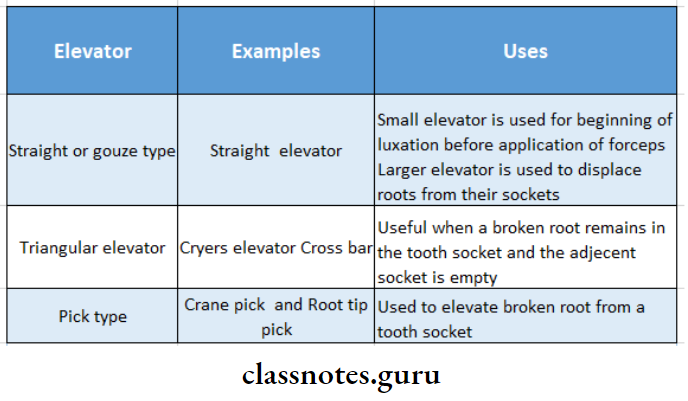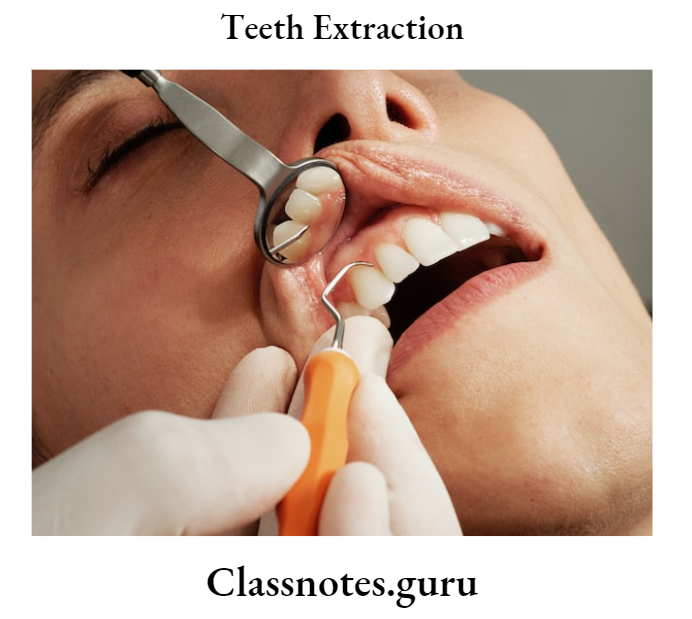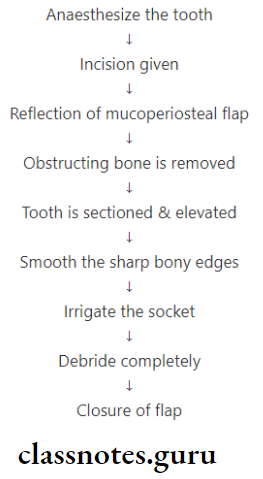Extraction Important Notes
1. Uses of elevators:
- To luxate the teeth by expanding the alveolar bone
- To Remove broken or Surgically Sectioned roots from their sockets
- Extraction of distal-most teeth in the arch
2. Types of Elevators:

3. Types of extractions:
- Intra-alveolar or closed technique: Extraction of the tooth by gaining direct access to the tooth to be extracted
- Trans alveolar or open technique: Access is gained by raising a mucoperiosteal flap or bone removal of the tooth
4. Contraindications of extractions:
Systemic contraindications Uncontrolled diabetes
- Bleeding diathesis
- Pregnancy
- Cardiac conditions
- Immunocompromised patients
- Endocrine malformations
- Local contraindications
- Acute infections
- Malignancy
- Radiation therapy
- Vascular lesions
- Pericoronitis
Absolute contraindications of extraction:
- Local hemangioma
- Arterioventral fistula associated with teeth
- Principles of the elevator:
- Lever principle
- Wedge principle
- Wheel and axle principle
- Order of extraction: Maxillary teeth are extracted first & then mandibular
- Principles of the elevator:
Sequence of extraction:
- Third molar
- Second molar
- Second premolar
- First molar
- First premolar
- Lateral & central incisors
- Canines

Extraction Long Essays
Question 1. Discuss objectives of tooth extraction
Answer:
Objectives of extractions:
- Selection of proper forceps or elevator:

- Efficient grip over instrument: Cross-hatching over the handles & serrations on the interior of the surface provides grip to the instrument
- Efficient position of operator & patient:
- For maxillary extraction – the maxillary occlusal plane should be parallel to the floor.
- The position of the patient should be 8 cm below the shoulder of the operator.
- For mandibular extraction- The retro line position of the patient should be maintained.
- Position of patient 16 cm below the elbow of the operator for mandibular extraction.
- The operator stands front & side to the patient except for the 4th quadrant extraction in which operators must stand behind the patient.
- Determine the direction of displacement of the tooth:
- Differentiate between simple & difficult extraction:
- Don’t hesitate to refer to the case
- Assess clinically & radiographically the difficulty of extraction
- Design properly the mucoperiosteal flap:
- The periosteal flap should provide proper exposure to the extraction site
- It should not tear off the mucosa
- Wound closure:
- Proper approximation of wound edges must be done
- Debride the socket properly
- Avoid any complications:
- Complete the procedure traumatically
- Avoid unnecessary damage to the site
- Post-operative instructions:
- Bite on the gauze piece placed over the extraction socket for a minimum of half an hour
- Reason: Stabilization of the clot in the socket
- Not to rinse mouth vigorously for the next 24 hours
- Reason: Causes dislodgement of the clot from the socket
- Avoid hot beverages:
- Causes vasodilation
- Intake of soft diet on the day of extraction:
- Hard food traumatizes the socket
- Avoid sucking through straws:
- Creates negative pressure
- Rinse with warm saline:
- To prevent infection
- Prescription of anti-inflammatory analgesics:
- To relieve pain
- Avoid smoking:
- It creates negative pressure
- If bleeding is not stopped visit the dentist
- Bite on the gauze piece placed over the extraction socket for a minimum of half an hour
Question 2. Discuss in detail indications, and principles in extractions. Note in complications.
Or
Indications of extractions
Answer:
Indications of Extractions:
- Unrestorable teeth
- Periodontally weak teeth
- Radiation therapy
- Teeth in the line of fracture
- Fractured teeth
- Pathology associated with teeth
- Malaligned teeth
Read And Learn More: Oral and Maxillofacial Surgery Question and Answers
- Orthodontic extractions
- Supernumerary teeth
- Retained deciduous tooth
- Extraction due to prosthetic reasons
- Impacted teeth
- Serial extraction
- Teeth in line of osteotomy
Principles of Extractions:
1. Expansion of bony socket:
- The tooth is held at its occlusal end with the help of force
- Move the forceps
- This expands the bony socket
- Makes easy removal of tooth

2. Wedge principle:
- Place the beaks of forceps between the tooth & socket in the periodontal space
- This displaces the tooth more occlusal
- If required place the forceps more apically
Complications of Extractions:
- Fracture of tooth
- Fracture of the alveolar process
- Fracture of maxillary tuberosity
- Fracture of jaw
- Damage
- To adjacent tooth:
- Soft tissues
- Nerve
- Displacement
- Into fascial spaces
- Hemorrhage
- Dislocation
- TMJ: Due to excessive mouth opening
- Jaw
- Postoperative complication
- Hemorrhage
- Pain
- Swelling
- Dry socket
- Trismus
- Infections
- Miscellaneous
- Oro antral fistula
Question 3. Describe in detail the complications of extractions, their prevention & management.
Answer:
Complications of Extractions:
- Fracture of tooth:
- Causes:
- Wrong forceps selection
- Improper force application
- Improper placement of forceps
- Grossly carious tooth
- Prevention:
- Selection of proper forceps Firm grip on forceps
- Apical wedging of forceps
- Use of root forceps in grossly carious tooth
- Management:
- If a small toothpiece remains, it gets resorbed
- If the root is fractured at the apical third, It is removed by the apexoelevator
- Transalveolar extraction done
- Causes:
- Fracture of the alveolar process:
- Cause:
- Excessive force application
- Prevention:
- Minimal force application to luxate the tooth
- Management:
- Small pieces are removed along the tooth Large pieces are replaced
- Cause:
- Fracture of maxillary tuberosity:
- Cause:
- Excessive forces
- Prevention:
- Correct application of forces
- Management:
- Replace it
- Suture it
- It heals in 4 weeks
- Cause:
- Fracture of the jaw:
- Causes:
- Improper selection of forceps Atropic mandible
- Prevention:
- Controlled force on instruments
- Estimate the difficulty of extraction before extraction
- Management:
- Reduction of fragments
- IMF done
- Causes:
Damage of Extractions:
- To adjacent tooth:
- Causes:
- Large restorations
- Grossly carious tooth
- Prevention:
- Correct placement of forceps interdentally avoids the application of forces close to adjacent teeth
- Management:
- Temporary restoration was given over the adjacent tooth.
- Replace it with a permanent restoration.
- Causes:
- Soft tissues:
- Causes:
- Slipping of instrument
- Placement of forceps over tissue rather than on tooth
- Prevention:
- Use of controlled forces
- Retract the tissues
- Plan the incision properly
- Management:
- Allow to heal the tissues
- Maintain oral hygiene
- Analgesics prescription
- Saline mouth rinses
- Causes:
- Nerve:
- Prevention:
- Assessment of pre-extraction radiograph
- Management:
- It regenerates
- Prevention:
Displacement of Extractions:
- Into fascial spaces:
- Causes:
- Excessive forces
- Fracture of cortical plates
- Prevention:
- Support the alveolus during extraction Application of controlled forces
- Management:
- Bringing the tooth back into the oral cavity If it is placed below the muscle then a reflection of the flap is done
- If it is uninfected, it is not treated
- Causes:
- Hemorrhage:
- Causes:
- Hypertension
- Damage to vessels
- Prevention:
- Atraumatic extraction
- Avoid damage to extraction
- Control the blood pressure before extraction
- Planning of incisions
- Avoid damage to nerves
- Management:
- Small bleeding, by application of pressure
- Anticoagulants are prescribed.
- Local anesthetic packs
- Suturing
- Cauterization of the spot Ligation of the artery
- Hemostatic agents
- Causes:
Dislocation of Extractions:
- TMJ: due to excessive mouth opening
- Jaw:
- Management:
- Manual reduction
- Restriction of movement
- Post-operative complication:
-
- Hemorrhage:
- Small bleeding, by application of pressure
- Anticoagulants
- Local anesthetic packs
- Suturing
- Cauterization of the spot
- Ligation of the artery
- Hemostatic agents
- Locate the bleeding at the point & stop it
- Pain: Anti-inflammatory and analgesic drugs
- Hemorrhage:
-
Swelling of Extractions:
- Causes:
- Edema
- Hematoma
- Infection
- Management:
- Resolves on its own
- Resolves on its own
- Drain the pus if there is drainage
- Dry socket:
- Analgesic
- Irrigate the socket
- Placement of abundant
- Trismus:
- May resolve on its own
- Manipulation of the jaw by jaw stretcher
- Infections:
- Anti-inflammatory drugs
- Miscellaneous:
- Oro antral fistula
Extraction Short Essays
Question 1. Transalveolar extraction.
Or
Open method of extraction.
Answer:
Transalveolar extraction
- It is an open method of extraction
- Also called the surgical method
- It is indicated when forceps extraction is difficult
Indications of Transalveolar extraction:
- Teeth resisting forceps extraction
- Sclerotic bone
- Unfavorable roots
- Hypercementosis
- Proximity to anatomic structures
- Grossly destroyed tooth
- Heavily restored tooth
- Root stumps
- Impacted tooth
Steps of Transalveolar extraction:

Question 2. Contraindications of extractions.
Answer:
Contraindications of extractions
- Systemic contraindications
- Uncontrolled diabetes
- Bleeding diathesis
- Pregnancy
- Cardiac conditions
- Immunocompromised patients Endocrine malformations Local
- contraindications
- Acute infections
- Malignancy
- Radiation therapy
- Vascular lesions
- Pericoronitis
Question 3. Etiology and management of post-extraction bleeding.
Answer:
Post-extraction bleeding
Post-extraction bleeding can be of three types
- Primary bleeding:
- Causes:
- Hypertensive patients
- When a blood vessel has been severed
- Management:
- Atraumatic extraction should be carried out
- Plan the incision properly
- Usually stops by application of pressure
- Causes:
- Reactionary bleeding:
- Cause
- Increase in blood pressure leading to opening up small divided vessels
- Management:
- Seat the patient
- Clean the oral cavity of all the clots
- Visualize the problem
- Locate the exact point of bleeding
- Stop the bleeding by applying pressure of
- At home, instruct the patient to place a clean handkerchief moist with cold water on the bleeding site and bite it on firmly
- Place a cold wet tea bag on the site
- The tannic acid in tea helps to precipitate protein and cause clot formation
- Cause
- Secondary bleeding:
- It occurs 7 days post-operatively
- Cause:
- Infections destroying the clot
- Management:
- Use of antibiotics to control infection
Extraction Short Question And Answer
Question 1. Absolute contraindications of extraction.
Answer:
Absolute contraindications of extraction
- Local hemangioma.
- Due to injury to the vessels
- Extravasations of blood into the tissue planes
- Arterioventral fistula associated with teeth
Question 2. Order of extraction.
(or)
Sequencing in full mouth extraction
Answer:
Order of extraction
Maxillary teeth are extracted first & then mandibular
Sequence of Order of extraction:
- Third molar
- Second molar
- Second premolar
- First molar
- First premolar
- Lateral & central incisors
- Canines
Question 3. Reactionary Haemorrhage.
Answer:
Reactionary Haemorrhage
Hemorrhage occurring within 8 hours of surgery
Causes of Reactionary Haemorrhag:
- Hypertension
- Postoperative sneezing
- Coughing
- Retching
- Example: Ligature slippage from superior thyroid artery
Question 4. Bone wax.
Answer:
Bone wax
It is a mechanical hemostatic agent
Composition of Bone wax:
- Benzoin
- Storax
- Balsam of tolu
- iodoform
- Solvent ether
Technique of Bone Wax:
- Place the bone wax on the bleeding spot
- Wait for half an hour
Mechanism of Bone wax:
- It occludes the blood vessel
Extraction Viva Voce
- The two teeth that are most difficult to remove are the first molar and canine
- In multiple extractions, maxillary teeth should be removed before mandibular teeth and posterior teeth before anterior teeth
- A dry socket is most common in the mandibular molar area
- According to Nitzan’s theory, the organism that is responsible for dry sockets is treponema denticola
- The extraction of the first molar to create space for the eruption of the third molar is called Wilkinson’s extraction
- For extraction of maxillary teeth, the occlusal plane is kept at 60° to the floor
- For extraction of mandibular teeth, the occlusal plane is parallel to the floor
- Cryer’s elevator works on wheel and axle and wedge principle
- Since the maxillary 1″ premolar has two roots which are curved and divergent, fracture occurs readily during extraction
- Extraction of tooth associated with central hemangioma results in profuse bleeding and death of the patient
- Cowhorn forceps are used for the removal of grossly decayed teeth
- Elevators are used for the extraction of distal-most teeth in the arch and the luxation of adjacent teeth
- The mandibular second premolar needs primarily rotatory movement to extract
- The elevators used in exodontia are functionally Class 1 and 2 levers
- To extract a tooth the whole of the inner surface of the forceps blade should fit the root surface
- The mechanical advantage would be maximum for an elevator when the effort arm is greater than the resistance arm
- The beaks of the extraction forceps should be placed on the root surface as far apically as possible
- The most common cause of post-extraction bleeding is the failure of the patient to follow post-extraction instructions
- Rongeur is commonly used to cut bone
- The best time of extraction in pregnancy is the second trimester.
